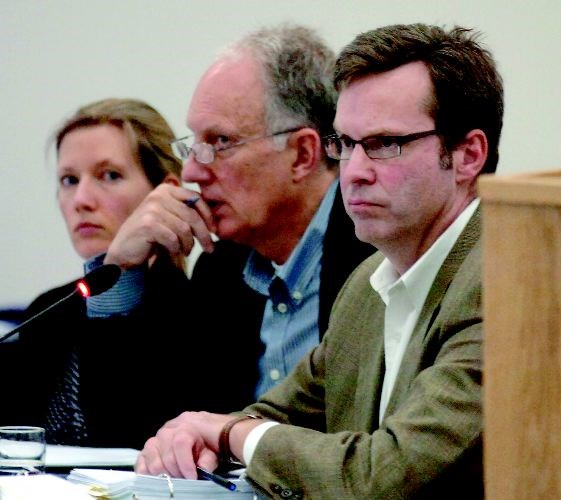Northern Gateway was unable to provide precise information on how it would access some of the more remote areas of its proposed pipeline under questioning from the provincial government Tuesday during National Energy Board (NEB) hearings in Prince George.
Christopher Jones, a lawyer for the province, wanted to know how much of the pipeline is located within two kilometres of existing roads and how much of the pipeline is accessible by boat, but officials from the Calgary-based company said that information isn't currently available.
Jones was asking about how Northern Gateway would access hardest to reach sections of the pipeline in the event of a spill, but was repeatedly told he'd have to wait until detailed plans were in place up to five years from now. If approved, Northern Gateway hopes to have the pipeline up and running by 2018.
"We are dedicated to working to develop those plans," Enbridge director of environment, lands and rights-of-way Kevin Underhill said during testimony. "These are all things we've committed to doing and we will be doing as we work towards construction."
Enbridge Northern Gateway engineering manager Ray Doering said the general public would be surprised at how close much of the proposed route is to existing roads, especially those used for logging.
"A vast majority of the route has been designated to be close to linear disruptions," he said, but was unable to provide an exact figure.
Enbridge senior manager of environmental operations Greg Milne said the company has proven in the past it can gain access to remote areas by use of helicopters, all terrain vehicles or snowmobiles when necessary.
"I think it would be fair to say we could get access to any appropriate spill control points at any location along the line," Milne said. "We see there are challenges, but we also see there is an ability [to do the job]."
The hearings are being conducted by a NEB Joint Review Panel and are examining the environmental assessment for the $6.5 billion proposal to connect Alberta's oilsands to Kitimat with twin diluted bitumen and condensate pipelines.
Jones was the first to ask questions of the second of three Northern Gateway witness panels to be seated in Prince George. Provincial Environment Minister Terry Lake and provincial legal advisor Geoff Plant were both critical of Northern Gateway's answers during the first round of questions last week because Northern Gateway often deferred detailed answers to a later date. Although the company didn't get into specifics again this time, both Lake and Plant declined to comment until the province wraps up its questioning on Wednesday.
The province has demanded that world class spill response be in place before it will consider approving the pipeline and Enbridge spokesman Ivan Giesbrecht believes the company is making that case.
"I think we've got off to a really good start here and this is going to be an really important session, or next phase for Enbridge, for Northern Gateway and for our interveners," Giesbrecht said during an interview after the hearings wrapped up for the day. "There's going to be a lot of very pointed questions, but these are questions we've prepared for. We are looking forward to answering them to be quite blunt about it."
Jones also asked questions about the 2010 spill of diluted bitumen in Michigan in 2010 and how Northern Gateway would be prepared to deal with the possibility the oil could sink.
After first saying that weathered bitumen wouldn't sink, Northern Gateway expert witness Matthew Horn clarified that it could sink if it mixed with sediments such as what happened in Michigan.
Underhill said from his perspective Enbridge did a good job cleaning up the sunken oil in Michigan and said the company would be prepared to clean it up if it happened in some of the fast-flowing waters in B.C. as well.
"It's difficult, but it's not insurmountable," Underhill said. "And I think we've proven that in Marshall [Mich.]"
The Michigan spill is something opponents of the pipeline point to often when challenging the company on its emergency preparedness and is expected to come up regularly during this witness panel's testimony.
"There's no question it was a terrible incident and it was a humbling incident for Enbridge," Giesbrecht said. "We're a very old company and we take pride in our safety record."
Giesbrecht also reiterated what a number of Northern Gateway witnesses said during testimony, that both the company and the pipeline industry as a whole learned from the Michigan spill and are now better equipped to deal with dilbit leaks.
"It has informed our learning and it continues to do that," he said. "What we've taken from that, we've applied to other parts of our operation, whether it's Northern Gateway or other areas."
Jones also set out a worse case scenario and wanted to know if 2,000 cubic metres of diluted bitumen was the most the company projects could escape in a full-bore rupture. Doering responded that the 2,000 cubic metre limit only applies to areas which have been designated as environmentally sensitive and that in other areas the amount could be higher.
The province will continue its questioning on Wednesday. Jones estimated that he will need the entire morning session. Skeena-Bulkley Valley MP Nathan Cullen is also expected to ask his questions on Wednesday.



